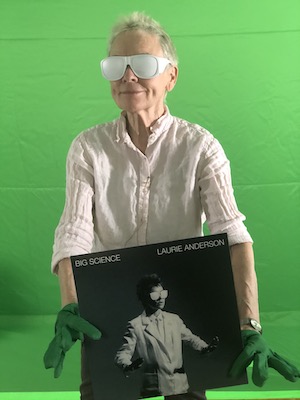By Nathan Kouri
Performance artist, inventor, pop musician, filmmaker, and artist-in-residence at NASA. To Laurie Anderson (ΦBK, Barnard College), the public life of an artist is more like an amusement park than a career. Even now, in her seventies, this Midwesterner-turned-New York-bohemian is doing anything but resting on her laurels. In 2019, she won her first Grammy. Heart of a Dog, her latest film, played at the 2015 Venice Film Festival, and its soundtrack was hailed by some critics as one of her best albums to date.
But in the past few weeks, Anderson made headlines for something she did forty years ago when Nonesuch reissued her 1982 debut album Big Science. While encompassing Anderson’s earlier lives as composer-violinist and gallery artist, Big Science introduced her anew as a rock ’n’ roller. Since then she’s been one of the few avant-gardists able to get a wider public to listen up—and keep listening. Like Yoko Ono, Anderson is too singular and fun-loving to be ignored. Her first release from Big Science, “O Superman,” was a surprise chart success, despite being over eight minutes long, musically minimal, and based around electronically-modulated spoken word. Along with its B-side “Walk the Dog,” her debut release must be the weirdest single to ever become a top-ten hit. That got her signed to Warner Brothers, and once a major label unleashed her on the airwaves, there was no going back.
The influence of Big Science has only grown in the decades since its initial release in the early 80s. Reverberations of Anderson make their way in the work of artists as disparate as Fiona Apple, Animal Collective, tUnE-yArDs, Cecelia Condit, Don DeLillo, and Joanna Newsom, to name just a few. In the wake of where popular music has gone since, the album’s genre-blending and electronic experiments seem remarkably prescient. In a recent interview with the BBC, Anderson even noticed a resemblance between the album’s imagery and current events. “I got my vaccine here at the Javits Center . . . . They gave everyone who got a shot a sticker, and it had an arm on it that looks exactly like the ‘O Superman’ cover . . . . I thought, whoa, this is big science. Or maybe it’s just Big Pharma, I don’t know.”
One of the fascinating aspects of Anderson’s work is the unusual way it engages with politics. She approached many of her modernist experiments in form with the 19th century ambition to capture the soul of her country, epitomized by her eight-hour performance art opus United States. Anderson has said her music in the 80s was “a picture of a culture inventing a digital world and learning to live in it. Big Science was about technology, size, industrialization, shifting attitudes toward authority, and individuality. It was sometimes alarmist, picturing the country as a burning building, a plane crash. Alongside the techno was the apocalyptic. The absurd. The everyday. It was also a series of short stories about odd characters—hatcheck clerks and pilots, preachers, drifters and strangers.” Reckoning with the fallout of our current disaster, we might turn to Anderson’s last three albums, which have moved away from the surreal satire of her early work and toward meditation: Heart of a Dog, on family and death; Landfall (with the Kronos Quartet), on Hurricane Sandy; and Songs from the Bardo (with Tenzin Choegyal and Jessie Paris Smith), an adaptation of The Tibetan Book of the Dead.
More reissues from Anderson’s catalog are coming soon, as is a major gallery retrospective when museums open up again. In 1979, a few years before Big Science made her a minor star, the New York Times called her, “the best and most popular performance artist of her age.” Little did they know that in 2021 we’d still be living in the age of Laurie Anderson.
Nathan Kouri earned his bachelor’s degree in English and cinema from the University of Iowa, where he was inducted into Phi Beta Kappa in 2019. The University of Iowa is home to the Alpha of Iowa chapter of Phi Beta Kappa.




